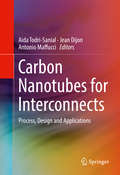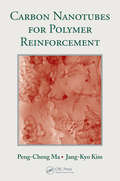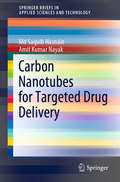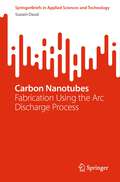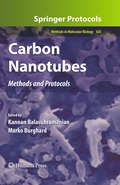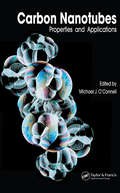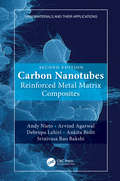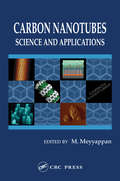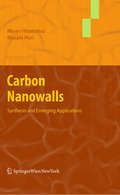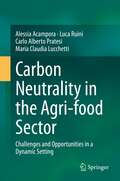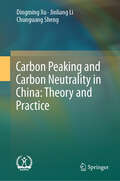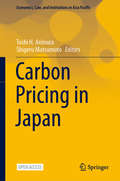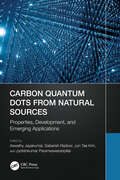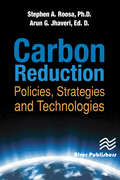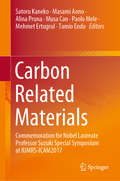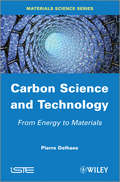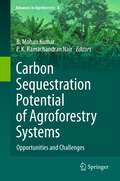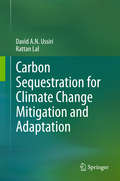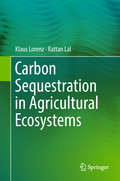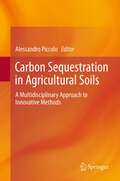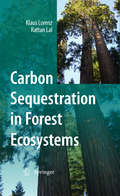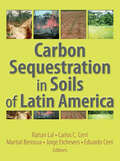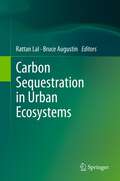- Table View
- List View
Carbon Nanotubes for Interconnects: Process, Design and Applications
by Antonio Maffucci Aida Todri-Sanial Jean DijonThis book provides a single-source reference on the use of carbon nanotubes (CNTs) as interconnect material for horizontal, on-chip and 3D interconnects. The authors demonstrate the uses of bundles of CNTs, as innovative conducting material to fabricate interconnect through-silicon vias (TSVs), in order to improve the performance, reliability and integration of 3D integrated circuits (ICs). This book will be first to provide a coherent overview of exploiting carbon nanotubes for 3D interconnects covering aspects from processing, modeling, simulation, characterization and applications. Coverage also includes a thorough presentation of the application of CNTs as horizontal on-chip interconnects which can potentially revolutionize the nanoelectronics industry. This book is a must-read for anyone interested in the state-of-the-art on exploiting carbon nanotubes for interconnects for both 2D and 3D integrated circuits.
Carbon Nanotubes for Polymer Reinforcement
by Jang-Kyo Kim Peng-Cheng MaDiscovered in the twentieth century, carbon nanotubes (CNT) were an integral part of science and industry by the beginning of the twenty first century, revolutionizing chemistry, physics, and materials science. More recent advances in carbon nanotube production methods have resulted in a tremendous push to incorporate CNTs into polymer matrices. Al
Carbon Nanotubes for Targeted Drug Delivery (SpringerBriefs in Applied Sciences and Technology)
by Amit Kumar Nayak Md Saquib HasnainThis book provides a detailed introduction to carbon nanotubes (CNTs) for targeted drug delivery. After a brief overview of the classification, preparation, and characterization of carbon nanotubes, it focuses on their use in targeted drug delivery. It presents CNTs for brain targeting, ocular targeting, cancer targeting, and lymphatic targeting, as well as antibody therapy. The book also includes chapters on carbon nanotubes for controlled drug delivery, transdermal drug delivery, solubility enhancement, vaccine delivery, gene delivery, and as quantum dots. Last but not least, it addresses the absorption and transportation of CNTs, toxicity and regulatory considerations, as well as clinical trials and the market status of CNTs. The book offers a comprehensive, self-contained reference guide, with all topics covered concisely and with the help of figures, tables and flowcharts.
Carbon Nanotubes: Fabrication Using the Arc Discharge Process (SpringerBriefs in Applied Sciences and Technology)
by Suzairi DaudThis book highlights a comprehensive understanding of the fabrication and growth of carbon nanostructures via the arc discharge process. Its content is designed to benefit academicians, students, researchers, scientists, and readers who are interested in gaining knowledge in this area. The book presents findings on the arc discharge process and provide detailed information on the optimal state and energy of carbon ions in arc discharge plasma, observed under different pressures and ambient environments. The contents presented here can be applied to enhance the performance of various applications. This book provides a valuable resource for those looking to gain a deeper understanding of the arc discharge process and the growth of carbon nanostructures, with practical applications in industries such as electronics, semiconductors, and energy storage.
Carbon Nanotubes: Methods and Protocols (Methods in Molecular Biology #625)
by Kannan Balasubramanian Marko BurghardDue to their rare combination of high chemical stability, exceptional optical and electrical properties, high surface-to-volume ratio, and high aspect ratio, carbon nanotubes (CNTs) have made an enormous impact on materials science, molecular biology, biomedicine, and bioanalytical chemistry. Carbon Nanotubes: Methods and Protocols provides reliable, consistent protocols on the application of CNTs in molecular biology-related fields. These are of vital importance, as the commercially available CNTs differ in purity, agglomeration state, as well as length and diameter distribution, all of which have a profound influence on the dispersability and surface properties of the tubes. The volume contains detailed sections on functionalization, toxicity, trafficking, scaffolds, and biosensors, provided by expert researchers from various fields. Written in the highly successful Methods in Molecular BiologyTM series format, chapters include introductions to their respective topics, lists of the necessary materials and reagents, step-by-step, readily reproducible laboratory protocols, and notes on troubleshooting and avoiding known pitfalls. Authoritative and cutting-edge, Carbon Nanotubes: Methods and Protocols serves to contribute to the achievement of common standards and helps researchers to avoid discrepancies in future biology-related CNT studies.
Carbon Nanotubes: Properties and Applications
by Michael J. O’ConnellSince their discovery more than a decade ago, carbon nanotubes (CNTs) have held scientists and engineers in captive fascination, seated on the verge of enormous breakthroughs in areas such as medicine, electronics, and materials science, to name but a few. Taking a broad look at CNTs and the tools used to study them, Carbon Nanotubes: Properties and Applications comprises the efforts of leading nanotube researchers led by Michael O’Connell, protégé of the late father of nanotechnology, Richard Smalley. Each chapter is a self-contained treatise on various aspects of CNT synthesis, characterization, modification, and applications. The book opens with a general introduction to the basic characteristics and the history of CNTs, followed by discussions on synthesis methods and the growth of “peapod” structures. Coverage then moves to electronic properties and band structures of single-wall nanotubes (SWNTs), magnetic properties, Raman spectroscopy of electronic and chemical behavior, and electromechanical properties and applications in NEMS (nanoelectromechanical systems). Turning to applications, the final sections of the book explore mechanical properties of SWNTs spun into fibers, sidewall functionalization in composites, and using SWNTs as tips for scanning probe microscopes. Taking a fresh look at this burgeoning field, Carbon Nanotubes: Properties and Applications points the way toward making CNTs commercially viable.
Carbon Nanotubes: Reinforced Metal Matrix Composites (Nanomaterials and their Applications)
by Arvind Agarwal Andy Nieto Debrupa Lahiri Ankita Bisht Srinivasa Rao BakshiThis discovery of carbon nanotubes (CNT) three decades ago ushered in the technological era of nanotechnology. Among the most widely studied areas of CNT research is their use as structural reinforcements in composites. This book describes the development of CNT reinforced metal matrix composites (CNT-MMCs) over the last two decades. The field of CNT-MMCs is abundant in fundamental science, rich in engineering challenges and innovations and ripe for technological maturation and commercialization. The authors have sought to present the current state of the-art in CNT-MMC technology from their synthesis to their myriad potential end-use applications. Specifically, topics explored include: • Advantages, limitations, and evolution of processing techniques used to synthesize and fabricate CNT-MMCs • Emphasizes dispersion techniques of CNTs in metallic systems, a key challenge to the successful and widespread implementation of CNT-MMCs. Methods for quantification and improved control of CNT distributions are presented • Methods for quantification and improved control of CNT distributions are presented • Characterization techniques uniquely suited for charactering these nanoscale materials and their many chemical and physical interactions with the metal matrix, including real-time in-situ characterization of deformation mechanisms • Electron microscope images from premier studies enrich discussions on micro-mechanical modeling, interfacial design, mechanical behavior, and functional properties • A chapter is dedicated to the emergence of dual reinforcement composites that seek to enhance the efficacy of CNTs and lead to material properties by design This book highlights seminal findings in CNT-MMC research and includes several tables listing processing methods, associated CNT states, and resulting properties in order to aid the next generation of researchers in advancing the science and engineering of CNT-MMCs. In addition, a survey of the patent literature is presented in order to shed light on what the first wave of CNT-MMC commercialization may look like and the challenges that will have to be overcome, both technologically and commercially.
Carbon Nanotubes: Science and Applications
by M. MeyyappanCarbon nanotubes, with their extraordinary mechanical and unique electronic properties, have garnered much attention in the past five years. With a broad range of potential applications including nanoelectronics, composites, chemical sensors, biosensors, microscopy, nanoelectromechanical systems, and many more, the scientific community is more moti
Carbon Nanowalls: Synthesis and Emerging Applications
by Masaru Hori Mineo HiramatsuRepresenting the first text to cover this exciting new area of research, this book will describe synthesis techniques of CNWs, their characterization and various expected applications using CNWs. Carbon-nanowalls (CNWs) can be described as two-dimensional graphite nanostructures with edges comprised of stacks of plane graphene sheets standing almost vertically on the substrate. These sheets form a wall structure with a high aspect ratio. The thickness of CNWs ranges from a few nm to a few tens of nm. The large surface area and sharp edges of CNWs may prove useful for a number of applications such as electrochemical devices, field electron emitters, storage materials for hydrogen gas, catalyst support. In particular, vertically standing CNWs with a high surface-to-volume ratio, serve as an ideal material for catalyst support for fuel cells and in gas storage materials.
Carbon Neutrality in the Agri-food Sector: Challenges and Opportunities in a Dynamic Setting
by Alessia Acampora Luca Ruini Carlo Alberto Pratesi Maria Claudia LucchettiThis book deals with the in-depth study of sustainability issues in the agri-food sector. In particular, a critical analysis of the current situation was developed and the future prospects of the sector on the issue of managing the environmental variable and the impacts relating to food production and consumption have been analyzed. Furthermore, the state of implementation and best practices relating to the carbon neutrality model in the agri-food sector were analyzed and models for the development of a new food production system were proposed with particular reference to the reduction of emissions, regeneration of natural resources, the elimination of waste and the reuse of production by-products. The main objectives of the book are to analyze the current situation and trends regarding carbon neutrality schemes and the connection with other greening programs, to identify and analyze the carbon-related labels, their methodology and their conformity assessment mechanisms and to understand possible key drivers for carbon neutrality or low carbon achievements in the agri-food sector.Today companies are acting on climate change pressures implementing carbon-neutral strategies for their brands and products. These frontrunner companies have identified a specific competitive advantage and are exploiting it to become the pioneers and the reference model for the carbon neutral implementation. This book will provide detailed and practical insights on how your organization can take positive action and be part of the global response developing a carbon neutral business.
Carbon Peaking and Carbon Neutrality in China: Theory and Practice
by Dingming Xu Jinliang Li Chunguang ShengChina has made a major strategic decision to achieve carbon peak before 2030 and carbon neutrality by 2060. The country has formulated a clear timetable, roadmap, and construction plan and introduced the “1+N” policy system from the top. This book provides a theoretical study and practical exploration of nine key aspects related to China's carbon peaking and carbon-neutral strategy: the background of Carbon Peaking and carbon neutrality, scientific and legal basis, strategic planning and path framework, energy-saving and carbon reduction measures, renewable energy, carbon sinks, carbon pricing mechanisms, the green financial system, and practical case studies.The translation was done with the help of artificial intelligence. The present version has been revised technically and linguistically by the authors in collaboration with a professional translator.
Carbon Pricing in Japan (Economics, Law, and Institutions in Asia Pacific)
by Toshi H. Arimura Shigeru MatsumotoThis open access book evaluates, from an economic perspective, various measures introduced in Japan to prevent climate change. Although various countries have implemented such policies in response to the pressing issue of climate change, the effectiveness of those programs has not been sufficiently compared. In particular, policy evaluations in the Asian region are far behind those in North America and Europe due to data limitations and political reasons.The first part of the book summarizes measures in different sectors in Japan to prevent climate change, such as emissions trading and carbon tax, and assesses their impact. The second part shows how those policies have changed the behavior of firms and households. In addition, it presents macro-economic simulations that consider the potential of renewable energy. Lastly, based on these comprehensive assessments, it compares the effectiveness of measures to prevent climate change in Japan and Western countries.Providing valuable insights, this book will appeal to both academic researchers and policymakers seeking cost-effective measures against climate change.
Carbon Quantum Dots from Natural Sources: Properties, Development, and Emerging Applications
by Jyotishkumar Parameswaranpillai Aswathy Jayakumar Sabarish Radoor Jun Tae KimCarbon quantum dots (CQDs) are a novel class of zero-dimensional carbon nanomaterials that are relatively nontoxic and cost-effective and offer desirable properties that make them excellent candidates for various applications. This book introduces the fundamentals of CQDs, natural sources and methods used for their synthesis, and characterization techniques. It addresses applications in biomedical, environmental, electrical, and other areas.• Covers current research and future possibilities• Details modern fabrication methods and drawbacks• Discusses applications in biomedical use, wastewater treatment, electrical and electronics, dye removal, 3D printing, and metal detection• Provides insight into cytotoxicity and biocompatibility studies on these materialsThe detailed insight into these nanomaterials in this reference will benefit researchers, scientists, engineers, and advanced students in developing new methods and strategies in this advanced field of materials engineering.
Carbon Queen: The Remarkable Life of Nanoscience Pioneer Mildred Dresselhaus
by Maia WeinstockThe life of trailblazing physicist Mildred Dresselhaus, who expanded our understanding of the physical world.As a girl in New York City in the 1940s, Mildred &“Millie&” Dresselhaus was taught that there were only three career options open to women: secretary, nurse, or teacher. But sneaking into museums, purchasing three-cent copies of National Geographic, and devouring books on the history of science ignited in Dresselhaus (1930–2017) a passion for inquiry. In Carbon Queen, science writer Maia Weinstock describes how, with curiosity and drive, Dresselhaus defied expectations and forged a career as a pioneering scientist and engineer. Dresselhaus made highly influential discoveries about the properties of carbon and other materials and helped reshape our world in countless ways—from electronics to aviation to medicine to energy. She was also a trailblazer for women in STEM and a beloved educator, mentor, and colleague. Her path wasn&’t easy. Dresselhaus&’s Bronx childhood was impoverished. Her graduate adviser felt educating women was a waste of time. But Dresselhaus persisted, finding mentors in Nobel Prize–winning physicists Rosalyn Yalow and Enrico Fermi. Eventually, Dresselhaus became one of the first female professors at MIT, where she would spend nearly six decades. Weinstock explores the basics of Dresselhaus&’s work in carbon nanoscience accessibly and engagingly, describing how she identified key properties of carbon forms, including graphite, buckyballs, nanotubes, and graphene, leading to applications that range from lighter, stronger aircraft to more energy-efficient and flexible electronics.
Carbon Reduction: Policies, Strategies and Technologies
by Stephen A. Roosa Arun G. JhaveriSignificant reduction of local, regional, national and international greenhouse gas emissions in homes, businesses, industries and communities has become an international priority. This book describes in clear, concise, and understandable terms the nature and scope of the climate change problem. The authors combine their considerable expertise to offer guidelines for defining and applying effective carbon reduction policies, strategies, and technologies. They propose a well-defined road map which can be implemented to help control and abate the alarming increases in carbon dioxide and other greenhouse gas emissions.
Carbon Related Materials: Commemoration for Nobel Laureate Professor Suzuki Special Symposium at IUMRS-ICAM2017
by Paolo Mele Tamio Endo Satoru Kaneko Masami Aono Alina Pruna Musa Can Mehmet ErtugrulThis book commemorates the “Nobel Laureate Professor Suzuki Special Symposium” at the International Union of Material Research Society–International Conference on Advanced Materials (IUMRS-ICAM2017), which was held at Kyoto University, Japan, in 2017. The book begins with a foreword by Professor Akira Suzuki. Subsequently, many authors who attended the special symposium describe the latest scientific advances in the field of carbon materials and carbon nanomaterials including polymers, carbon nanocomposites, and graphene. Carbon-based materials have recently been the focus of considerable attention, given their wide range of potential applications. Fittingly, the chapters in this book cover both experimental and theoretical approaches in several categories of carbon-related materials.
Carbon Science and Technology: From Energy to Materials
by Pierre DelhaesCarbon solids have been utilized by man since prehistoric times, first as a source of heat and then for other purposes; these are used as key markers for different civilizations. The essential role played by the use of coal mines during the industrial revolution as a main source of energy is a crucial point, which was then expanded through the development of carbochemistry. This book begins by describing the use of solid carbons as traditional materials, for example in the steel industry and for ceramics, then moving on to their technological uses such as active carbons and carbon fibers, etc., before discussing nanocarbons, the jewel in the crown of contemporary technological science. The final chapter analyzes the current economic and social impact of carbon solids.
Carbon Sequestration Potential of Agroforestry Systems: Opportunities and Challenges (Advances in Agroforestry #8)
by P. K. Nair B. Mohan KumarTree based production systems abound especially in the tropics. Despite the pervasiveness of such multipurpose "trees-outside-forest" resources, they have not attracted adequate attention in the development paradigms of many nation states. These multispecies production systems impact the ecosystem processes favourably. Yet, our understanding of the diversity attributes and carbon dynamics under agroforestry is not adequate. This book focuses on the role of multispecies production systems involving tree and crop species as a means for carbon sequestration and thereby reduce atmospheric carbon dioxide levels. Sixteen chapters organized into three broad sections titled: Measurement and Estimation, Agrobiodiversity and Tree Management, and Policy and Socioeconomic Aspects represent a cross section of the opportunities and challenges in current research and emerging issues in harnessing carbon sequestration potential of agroforestry systems.
Carbon Sequestration for Climate Change Mitigation and Adaptation
by Rattan Lal David A. UssiriThis book provides an understanding of the role of human activities in accelerating change in global carbon cycling summarizes current knowledge of the contemporary carbon budget. Starting from the geological history, this volume follows a multidisciplinary approach to analyze the role of human activities in perturbing carbon cycling by quantifying changes in different reservoirs and fluxes of carbon with emphasis on the anthropogenic activities, especially after the industrial revolution. It covers the role of different mitigation options – natural ecological, engineered, and geoengineered processes as well as the emerging field of climate engineering in avoiding dangerous abrupt climate change. Although the targeted audience is the educators, students, researchers and scientific community, the simplified analysis and synthesis of current and up to date scientific literature makes the volume easier to understand and a tool policy makers can use to make an informed policy decisions.
Carbon Sequestration in Agricultural Ecosystems
by Klaus Lorenz Rattan LalA comprehensive book on basic processes of soil C dynamics and the underlying factors and causes which determine the technical and economic potential of soil C sequestration. The book provides information on the dynamics of both inorganic (lithogenic and pedogenic carbonates) and organic C (labile, intermediate and passive). It describes different types of agroecosystems, and lists questions at the end of each chapter to stimulate thinking and promote academic dialogue. Each chapter has a bibliography containing up-to-date references on the current research, and provides the state-of-the-knowledge while also identifying the knowledge gaps for future research. The critical need for restoring C stocks in world soils is discussed in terms of provisioning of essential ecosystem services (food security, carbon sequestration, water quality and renewability, and biodiversity). It is of interest to students, scientists, and policy makers.
Carbon Sequestration in Agricultural Soils: A Multidisciplinary Approach to Innovative Methods
by Alessandro PiccoloThis compilation of techniques, methodologies and scientific data arises from a four-year Italian research project, which took place at university research stations in Turin, Piacenza, Naples and Potenza. Soil Organic Matter (SOM) represents an active and essential pool of the total organic carbon on the planet. Consequently, even small changes in this SOM carbon pool may have a significant impact on the concentration of atmospheric CO2. Recent new understanding of the chemical nature of SOM indicates that innovative and sustainable technologies may be applied to sequester carbon in agricultural soils. Overall results of the project have been applied to develop an innovative model for the prediction and description, both quantitatively and qualitatively, of carbon sequestration in agricultural soils. This book provides experts in different areas of soil science with a complete picture of the effects of new soil management methods and their potentials for practical application in farm management.
Carbon Sequestration in Forest Ecosystems
by Klaus Lorenz Rattan LalCarbon Sequestration in Forest Ecosystems is a comprehensive book describing the basic processes of carbon dynamics in forest ecosystems, their contribution to carbon sequestration and implications for mitigating abrupt climate change. This book provides the information on processes, factors and causes influencing carbon sequestration in forest ecosystems. Drawing upon most up-to-date references, this book summarizes the current understanding of carbon sequestration processes in forest ecosystems while identifying knowledge gaps for future research, Thus, this book is a valuable knowledge source for students, scientists, forest managers and policy makers.
Carbon Sequestration in Soils of Latin America
by Martial Bernoux Rattan Lal Carlos C. Cerri Jorge Etchevers Eduardo CerriDiscover the latest available knowledge on ways to reduce CO2 in the atmosphere!The problem of quickly mounting CO2 emissions in the fast-developing Latin American region was addressed in a symposium held in Piracicaba, Brazil, in June 2004. Carbon Sequestration in Soils of Latin America presents the latest available knowledge in soil C
Carbon Sequestration in Urban Ecosystems
by Rattan Lal Bruce AugustinUrbanization drastically alters the ecosystems structure and functions, disrupts cycling of C and other elements along with water. It alters the energy balance and influences climate at local, regional and global scales. In 2008, urban population exceeded the rural population. In 2050, 70% of the world population will live in urban centers. The number of megacities (10 million inhabitants) increased from three in 1975 to 19 in 2007, and is projected to be 27 in 2025. Rapid urbanization is altering the ecosystem C budget. Yet, urban ecosystems have a large C sink capacity in soils and biota. Judicious planning and effective management can enhance C pool in urban ecosystems, and off-set some of the anthropogenic emissions. Principal components with regards to C sequestration include home lawns and turfs, urban forests, green roofs, park and recreational/sports facilities and urban agriculture.
Carbon Shock
by Mark SchapiroAs the world moves toward making more and more polluters pay to emit carbon, a financial mystery unfolds: What are the costs? Who has the responsibility to pay for them? Who do you pay? How do you pay? And what are the potential impacts? These are the questions veteran journalist Mark Schapiro attempts to answer as he illuminates the struggle to pinpoint carbon’s true costs and allocate them fairly—all while bumping up against the vagaries of the free market, the lobbying power of corporations, the political maneuverings of countries, and the tolerance of everyday consumers buying a cup of coffee, a tank of gas, or an airplane ticket. Along the way, Schapiro tracks the cost of carbon through the drought-ridden farmland of California, where higher temperatures are driving up the price of the food we eat, the prices farmers pay for crop insurance, and the impact on taxpayers. Through the jungles of Brazil, where foreign polluters pay to keep trees standing—as offsets to absorb CO2—at a fraction of the cost they are worth to the struggling communities around them, who engage in logging or other uses. Through the world's greatest manufacturing center, asking who should pay for the pollution generated there—the Chinese who operate the factories or the Westerners who consume the goods they produce? Through the skies, where recent efforts to put a price tag on the carbon left by airplanes in the no-man's land of the atmosphere created what amounted to a quiet but powerful global trade war. Through the carbon-trading capital of Europe, where economists try to establish a price for a bizarre new commodity—a ton of carbon that will not be emitted—literally selling the air in an effort to curtail emissions. And, finally, through the high-tech crime world the new carbon markets have inspired, and the emerging nations that—as they amp up manufacturing, put more cars on their streets, and up their consumption—teeter on the brink of this wild, new carbon economy. For almost two decades, the primary topic of global climate negotiations has been to find a way to pay for the costs of carbon, slow greenhouse gas emissions, and stimulate a shift away from fossil fuels in order to shrink the earth’s carbon footprint. The key tool to date—the international carbon trade—has foundered in a sea of questions deftly explored by Schapiro, and in the turmoil of a global recession. As we approach the next climate negotiations in 2015, will nations stick to business as usual? Or will the world come to terms with the real price for carbon, and figure out a sensible way to pay for it?
